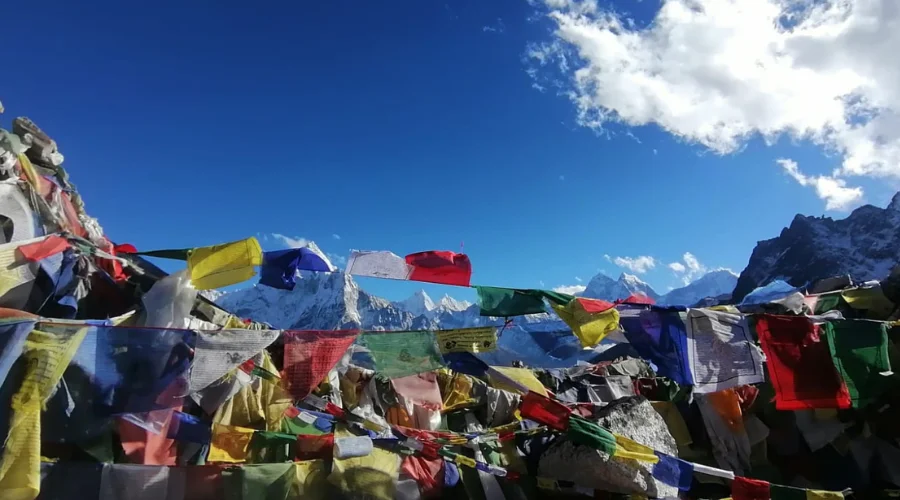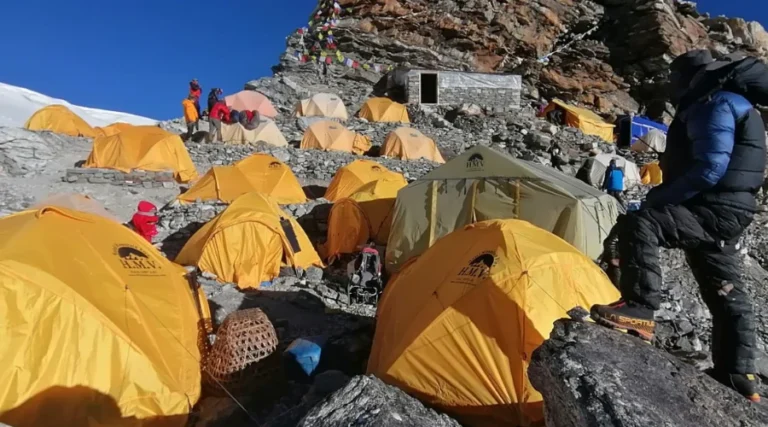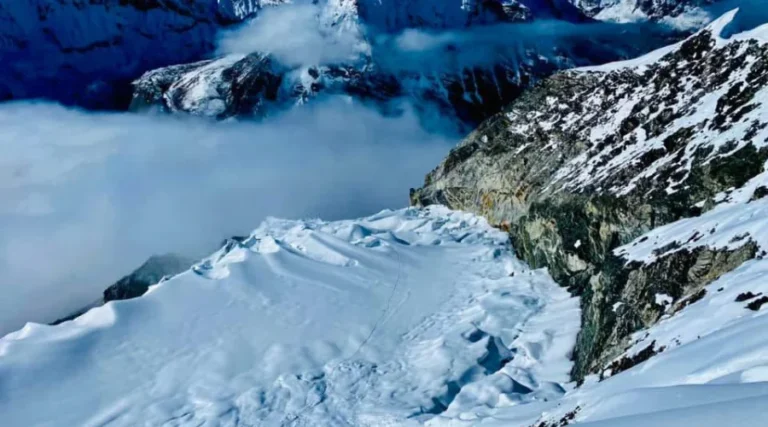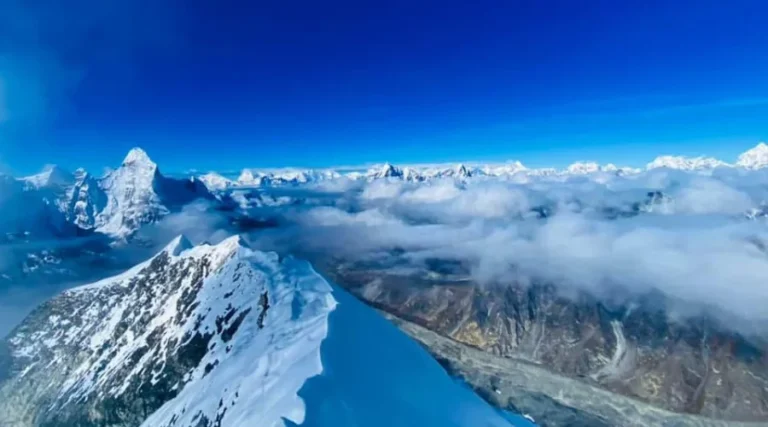Island Peak Climbing with Everest Base Camp Trek
-

Trip Duration 19 Days
-

Max, Altitude 6165 meters
-

Type Standard
-

Best Season Sept - May
-

Meals Included
-

Accommodation Guest House
-

Activity Trek and Climb
-

Difficulty Challenging
- Scenic flight to Lukla offering breathtaking mountain views
- Trekking through charming Sherpa villages and vibrant landscapes
- Visiting the iconic Everest Base Camp
- Breathtaking views of Everest Lhotse Ama Dablam and the surrounding peaks.
- Experiencing Sherpa culture and their warm hospitality
- Climbing Island Peak with expert guides and necessary equipment
- Walking across glaciers and enjoying thrilling ridge climbs
- Standing at 6189 meters with panoramic Himalayan views
Island Peak climbing with Everest Base Camp Trek is the selling package trek combined with sightseeing and climbing. It is precisely what adventurers need that they can get in the Himalayas as an adventure.
So, the Island Peak Climb starts in Khumbu and passes through friendly Sherpa villages, historic monasteries, and vibrant rhododendron forests.
During this trek, you will be rewarded with beautiful mountain sights, including Mount Everest, Mount Lhotse and Mount Ama Dablam.
Everest Base Camp Trek is a major attraction for trekkers because it is the leading destination in the region. The next step is to ascend Island Peak, which is 6,189m/ 20,305 ft.
The ascent involves passage over glaciers, rope work, and ridge navigation. The Island Peak summit offers stunning panoramas of the Everest peaks, which are well worth the effort.
Island Peak Climb requires good physical fitness and determination, but it can be done with appropriate acclimatization and the supervision of seasoned professionals.
It’s a safe and enjoyable experience. You’ll stay in cozy tea houses, enjoy warm Sherpa hospitality, and learn about the local culture.
No matter what the first climb or the next level, the experience is unique. It is about climbing to the peak, unmasking the mountains’ quality, and accomplishing something extraordinary.
About Island Peak Climbing
Imja Tse, also known as Island Peak, is an easy-to-climb peak in the range of ten peaks in Nepal, reaching an altitude of 6189 meters. It lies in the province of Everest and is visible with Lhotse and Ama Dablam, Makalu, among other stunning mountains.
The Island Peak Climbing is moderate and is recommended to hikers who would like to get a taste of mountaineering while facing the serious difficulties of rock climbing. Ascent consists of glacier walks, ropes, and ice climbing on steep slopes; it offers a good alpine experience.
The desire to reach the top is physically exhausting, but the magnificent view of the Himalayas is a big reward for climbers. Many climbers prefer Island Peak as a preliminary climb to other more prominent regional peaks, including Everest.
The climbing experience is a must, and it is a favourite of those who wish to challenge themselves and ‘feel’ the stunning Nepali hills and mountains.

Short Itinerary
Itinerary of Island Peak Climbing with Everest Base Camp Trek
You’ll land at Tribhuvan International Airport, where our representative will warmly welcome you. After hotel check-in, you’ll meet your guide for a detailed trip briefing. Spend the evening strolling through the centre of Thamel.
- Hotel in Kathmandu
The flight to Lukla is only the beginning of the journey. Along the way, one will cross lush green farmland dotted with small settlements and prayer flags.
You will walk along the Dudh Koshi River. Everyone will be crossing suspension bridges at the edge of the serene village of Phakding. After walking for 3-4 hours, you reach Phakding.
- Teahouse
- Breakfast, Lunch, Dinner
The day begins with a walk by the river along pines and rhododendrons. The trek gently ascends, crossing suspension bridges with prayer flags.
It is interesting that when travelling to Sagarmatha National Park, you can see the beautiful view of the snowy peaks. You will cross beautiful villages along the way.
Namche is a lively Sherpa settlement with spectacular views and an opportunity to see the vibrant market.
- Teahouse
- Breakfast, Lunch, Dinner
A day of rest is needed to acclimatize to altitude, but it is not an actual rest day. You will hike towards the Everest View Hotel and then return to the hotel again. You will admire the grand spectacle of Everest, Lhotse and Ama Dablam. You can try the local foods and bakery products in the Namche Bazar.
We will visit the Hillary School and the Khumjung Gompa, which displays a scalp that the monastery claims belongs to the mythical Yeti. This is a good opportunity to learn more about Sherpa culture, taste local cuisine, and observe the never-ending views of the Himalayas. After our day of exploration, we will return to Namche Bazaar.
- Teahouse
- Breakfast, Lunch, Dinner
On the Everest to Ama Dablam route, there is spectacular scenery to take all the way through. The trek is a slow ascent to a most serene and ancient Tengboche village.
Tengboche Monastery is a peaceful monastery with a backdrop of magnificent peaks. The monastery has been there for ages.
- Teahouse
- Breakfast, Lunch, Dinner
Today, you’ll cross the picturesque village of Pangboche, where houses of stone are present and provide a sight of the old Himalayan way of life.
The following ground to Dingboche is a high plain with a breathtaking open, panoramic alpine landscape. The views of the mountains will start magnifying.
- Teahouse
- Breakfast, Lunch, Dinner
It’s another rest day to adjust to the high altitude. A short trail to Nagarjun Hill offers a spectacular view of the Makalu and Lhotse peaks. You can wander around the pretty village or rest in the soft embrace of the tea house restaurants.
- Teahouse
- Breakfast, Lunch, Dinner
Today, one will go across the ground with scattered loose rocks and glacial till incident in the trail. Thukla Pass is a challenging climb, but it is also very significant, as there are memorials to those who have perished or attempted to climb Everest.
The view from the Lobuche trail is breathtaking; the Khumbu Glacier shines in the sunshine under a glorious light.
- Teahouse
- Breakfast, Lunch, Dinner
Although the journey to Gorakshep is difficult, it is also physically and psychologically stressful. However, it is one of the best days one has been waiting for.
Seeing these colourful, moving formations of hikers against the vast, majestic wilderness of the Khumbu Icefall is a view you will never get over once you get to EBC. Standing there, you will feel an overwhelming sense of success and wonder. Then, return to Gorakshep for the night.
- Teahouse
- Breakfast, Lunch, Dinner
Hiking to Kala Patthar at sunrise is one of Everest’s most cinematically photographed views. In the spectacular afternoon sunlight, you will see the majestic view of Mount Everest, the highest peak in the world.
After descending, you’ll head toward Chhukung. The road is hollow, and the impressive elevation is just before you. The exhaustion is absolute, but the satisfaction is unmatched.
- Teahouse
- Breakfast, Lunch, Dinner
The trekker’s destination is the base camp of Island Peak. The trail, for the most part, is scrubby with a mix of gravel and sloughed snow and ice.
The climb test measures its physical strength, but the climb itself, while the climber waits, provides a reason to arrive. Island Peak Base Camp is scenic, with towering mountains in the background.
- Teahouse
- Breakfast, Lunch, Dinner
Our pre-climb training begins today. The training will be delivered through our guides. They will train you properly using climbing gears like the ice axe, climbing boots and crampons, harnesses, ascenders, etc., using ropes to move up and down, and peak climbing techniques.
The training isn’t compulsory, but we strongly recommend it as some training experience will give you the confidence and climbing skills to scale the summit successfully and enjoy the entire experience. We can either spend the day hiking to a higher camp and back or resting for the ultimate climb. Overnight at the base camp.
We start the day very early, waking up between 12 and 1 a.m., having breakfast, and starting the climb. We must start very early because reaching the summit before noon is paramount. Strong winds in the highlands during the afternoon can hinder our success.
The trail leads hundreds of meters from the base camp until it strikes off a steep hillside. The path from here is sandy, then turns to grass and becomes boulder-strewn. Climbing further, the slope narrows, and the trail enters a steep rock channel.
We ascent the rock gully. We move through several short rock steps to climb before emerging on the right side of the gully. We then follow a ridgeline leading to an exciting and exposed traverse onto the snout of the summit glacier. Our guides will fix the roles where necessary. We climb a steep snow ridge towards the summit ridge. Fixed rope and man rope will be used through the ascent.
We will use fixed rope after climbing on the rock. The length of the rope depends on the time of the season and the crevasses. We will also use ladders to cross crevasses where necessary. After all the challenges, we make it to the summit, enjoying the magnificent views.
After the triumph, we will move to Island Peak Base Camp, where celebrations wait.
- Island Peak Base Camp
- Breakfast, Lunch, Dinner
Take a break or do whatever is needed today. This day is kept as an extra day in case of bad weather. If you have already summited, you can rest on this day.
- Island Peak Base Camp
- Breakfast, Lunch, Dinner
Now, it’s all downhill from here, but it’s an enjoyable one, though. We trace our steps through the wide valley of Khumbu Khola, passing through the beautiful Sherpa villages of Orsho and Shomare.
We can take an alternate trail to visit the Gompa in Upper Pangboche, considered the oldest in the Khumbu region, or take the regular route to reach Pangboche. Enjoy brilliant views ofAmaDablam, Thamserku, Kangtaiga, the Kongde range and the ImjaTse river from Pangboche.
- Teahouse
- Breakfast, Lunch, Dinner
Again, we retrace our steps fromPangbochetowards Tengboche. We then pass through rhododendron and juniper forests to reach a bridge over the DudhKoshi River. On crossing the bridge, the trail follows the DudhKoshi gorge, which descends quickly through pine forests to reach Sansa.
If lucky, we might spot mountain goats, snow leopards, and colourful pheasants while passing through the forest. Finally, after a chorten, we reach Namche Bazaar.
- Teahouse
- Breakfast, Lunch, Dinner
Every step brings a mix of joy and nostalgia. Getting to Lukla would be the chance to say team since it is not just the achievement point.
But the time spent there, and having a taste of the pleasure of being there, with a group meal celebration and the opportunity to tell the adventure story.
- Teahouse
- Breakfast, Lunch, Dinner
We will catch an early morning flight to Kathmandu for some last-minute souvenir shopping and celebration! You can also visit other places in Kathmandu; we will assist you. A farewell dinner will be arranged to celebrate your success.
- Hotel in kathmandu
- Breakfast, Lunch, Dinner
This is your last day in Nepal. It’s time to say goodbye, but we hope we’ll meet again! Our representative will escort you to the airport three hours before the scheduled flight.
Have any Questions? Check out FAQ'S
Trip Essential Information
Island Peak Climb with Everest Base Camp Trek Difficulty
Because of their altitude and climbing features, the Island Peak Climb and the Everest Base Camp Trek are categorized as complex.
The Island Peak Climbing involves a single day of challenging track along the rigid surface, incline, decline, and several upgrades, thus challenging the physical and mental spirit.
Altitude is a significant concern in the two destinations because participants develop respiratory problems with low oxygen pressure when they reach EBC at 5,364 meters or climb to Island Peak at 6,189 meters, with a likelihood of getting altitude illnesses.
The ascent demands relatively little of the mountaineer regarding technical ability, with no crampons, ropes or ice axes. Strenuous ice barriers, low rims, and glacier crossings also narrowly qualify the technical aspect, especially for all amateurs.
The climate of the Himalayas is unsettled and severe, and gales make the ascent even more challenging. Proper acclimatization, preparation, and training are essential to safely accomplishing this excellent but laborious task.
Island Peak Climbing Altitude Sickness
Island Peak Climbing with the Everest Base Camp Trek One of the most common issues hikers face is altitude sickness. It occurs when the body fails to acclimate to low oxygen concentrations more familiar to the high altitude.
Diagnosis involves headache, dizziness, nausea, sometimes fatigue, and sleeping problems. The risk begins at altitudes above 2500m and moderately rises to 3000 m.
The ascent to EBC at 5,364m and Island Peak at 6,189m puts the trekkers in this altitude region. Hypoxia, heat, inadequate cardiovascular adaptation, dehydration, weight loss, poor physical fitness, and overtraining are some of the things that make it worse. Proper acclimatization is the key to prevention.
Rest, slow pacing, and water intake are essential. HAPE or HACE sets in, so any sign of worsening needs immediate descent to a lower altitude.
Meals During Island Peak Climbing
Food provided for the Island Peak Climbing as part of the Everest Base Camp Trek is essential but healthy. Tea houses situated on the route offer food with calories for trekking and climbing. Breakfast usually includes porridge, eggs, toast or pancakes, and tea or coffee.
For lunch and dinner, the choices are dal bhat, noodles, pasta, rice, soup, or potatoes. Leafy greens can be found at lower elevations but disappear at high elevations. Protein options like eggs or lentils are standard.
Smalls such as chocolate bars or energy bars may be purchased or carried. Hydration is essential, so tea, coffee, and boiled water are on the menu. Food is simple but adequate to support trekkers on their strenuous hikes.
Accommodation in Everest Island Peak Climbing Nepal
Accommodations during the Island Peak Climb and the Everest Base Camp Trek are easy and pleasant. In villages along the trail, you stay in teahouses. These are small lodges run by local families.
Rooms are rudimentary, usually with twin beds and en suite bathrooms. Teahouses are cozy spots to relax, and great meals are served. The presenters are cheerful and warmly accommodating to their guests. As you climb higher, facilities become more essential.
The climber is housed in tents at the Island Peak climb camp base. These tents provide sleeping bags and shelter during freezing temperatures. Even if minimalist, these facilities are comfortable and offer a small opportunity to experience the local culture and mountain ecology.
Distance of Island Peak Climb with Everest Base Camp Trek
The overall distance of the Island Peak Climb with Everest Base camp trek is approximately about 130kilometers.
The trekking distance from Lukla to the Everest Base Camp is about 40 miles.
The EBC to Island Peak trail is about 15 km one way up to the summit. These are the trek from Island Peak Base Camp to its highest point, the summit, 6,189m.
Typical Day during the Island Peak Climbing
The average daily time spent during the trek to the EBC is 5-7 hours over the varying terrains of natural geography.
The best time in the morning has clear visibility of the mountains, and the temperatures are not as hot. Lunch is at a scenic spot.
Afternoons involve climbing higher or descending to acclimatize. Evenings are spent socializing with fellow trekkers or resting.
A typical day while Climbing Island Peak involves climbing before dawn, around 1–2 AM, to avoid afternoon winds. You dress in climbing gear and climb glaciers and steep slopes/ridges.
It’s a slow and steady pace guided by professionals. Arrival at the summit is an exciting experience with a fantastic vista. Subsequently, you plunge back to base camp, satisfied but weary.
Permits for Island Peak Climb with Everest Base Camp Trek
Three permits are required to climb Island Peak and trek to Everest Base Camp. Each is essential and ensures a smooth journey.
Nepal Mountaineering Association (NMA) Permit
This permit is mandatory for climbing Island Peak. The Nepal Mountaineering Association issues it. The cost varies depending on the season. Spring is more costly, and autumn, winter, and summer are less expensive.
Sagarmatha National Park Entry Fee
This permit allows access to the Everest region. It is also needed to enter Sagarmatha National Park, a UNESCO World Heritage Site. The permit can be obtained from Kathmandu or Monjo, the park’s entry point.
Local Area Permit (Pasang Lhamu Rural Municipality Permits
The local government issues this permit. It is necessary to trek in the Khumbu region. It supports local development and conservation efforts.
These permits are easily secured with the assistance of a trekking agency or guide. They are routinely checked at multiple stages of the trek, so ensure they are easy to find. With these permits, you can walk legally to help protect the region and the local communities.
Best Time for Island Peak Climbing
The best times for the Island Peak Climb with Everest Base Camp Trek are spring (March to May) and autumn (September to November). These seasons offer stable skies, good weather, and great views of the mountains.
Selection of the appropriate time guarantees a safer and more comfortable hiking trip. The trails are more accessible, and climbing conditions are perfect.
You can enjoy warm days and manageable cold nights. However, there are drawbacks and risks during the monsoon (June to August) and winter (December to February) off-seasons.
Monsoon brings heavy rains, slippery trails, and leeches. Winter has cold temperatures, snowy surfaces and strong winds, so climbing is difficult. Nevertheless, off-season walking has fewer people and lower expenses.
However, weather hazards, layover delays, and risk management are more significant. Selection of the right time leads to a more pleasant experience with fewer obstacles.
Travel Insurance for Island Peak Climb
Travel insurance is an Island Peak Climbing with Everest Base Camp Trek lifesaver. The walk is at a high altitude, involves extreme weather, and is on difficult ground. These uncertainties can result in unforeseen risks such as altitude sickness, injuries, or disruptions because of weather.
Good travel insurance provides coverage for emergencies. This includes helicopter evacuation, medical treatment, and trip cancellations.
It also addresses lost baggage or equipment, which is highly relevant in remote locations. Altitude sickness is a real risk during this trek.
Evacuation by helicopter can cost thousands of dollars; without insurance, this expense becomes a burden. The weather in the Himalayas is unpredictable.
Delays or cancellations of flights to Lukla are common. Insurance can help cover these unexpected costs. If not directly necessary, selecting trekking travel insurance up to and including 6,000 metres is potentially required.
It guarantees a safe and peaceful transport experience. Good insurance lets you concentrate on the trip and hike with less anxiety.
Drinking Water
Drinking is crucial for the Island Peak Climb and Everest Base Camp Trek. Hydration prevents altitude sickness and is energizing. You can buy bottled water on the trail, but it gets expensive as you go along.
A better option is to refill bottles with boiled or filtered water available at teahouses. Keeping a reusable bottle and purification tablets is advisable to prevent illness. To prevent infection, do not drink untreated water from streams or taps.
Always ensure your water is safe to drink. Proper hydration is the key to good health and success on the trail.
WiFi, Electricity, and Communication.
Wi-Fi, electricity, and communication are available on the Island Peak Climbing to Everest Base Camp Trek; however, they are rudimentary. Teahouses in villages offer Wi-Fi for a small fee. Nevertheless, this connection is slow and unreliable, particularly at altitude.
Mobile network presence is provided in certain areas but may not be effective in remote areas or adverse weather.
Electricity is provided in the teahouses for charging devices but is at an extra cost. Since power sources are scarce, carrying a power bank in emergencies is advisable. The Island Peak trek does not have Wi-Fi or a 4G mobile network.
Communication is challenging in this Island Peak Climbing area. Guides usually carry radios for emergency contact. It is also preferable to warn family or friends about limited communication. Being disconnected lets you appreciate the beauty of the trek and the journey itself.
Frequently Asked Questions (FAQ)
You get caught with altitude sickness when your body can’t adjust with the changing elevation. So you should appropriately acclimatize as you gain height and take legitimate breaks.
Remaining hydrated is additionally a significant step to avoid altitude sickness. Having a proper diet and taking appropriate breaks is like a mandatory requirement to avoid the risk of altitude sickness. Likewise, avoiding alcoholic drinks and smoking has additionally proven to be useful.
The highest altitude you will climb is the altitude of 6189 meters at the top of Island Peak.
Island Peak climbing falls under one of the easy climbing adventures of Nepal. It is one of the most popular and favorable peaks for beginners. With no specialized parts, it is the ideal peak for beginners to try out their climbing skills. There are a few challenges during the trip yet you can generally overcome these with appropriate preparations.
The best time for summiting the Island Peak is in the autumn and spring season from September to November and March to May respectively. As the views become clear during these seasons.
Indeed, you need travel insurance for any high altitude trek or climb. So in case of any emergencies, your travel insurance will help you out for any rescue operation. Without travel insurance, your rescue charges will be difficult to handle.
No, you don’t need to have any climbing equipment. We will provide all of the necessary mountaineering equipment. You just require to bring personal and trekking equipment. Otherwise, you may also buy or rent all those things after your arrival.
In case of any emergencies, you are requested to immediately inform the guide or the one in charge of the group. Then will be immediately taken to the nearest medical facility for immediate treatment. If you are at a higher altitude you will be rescued via helicopter emergency rescue.
The Cancellation will be made if you inform us prior 30 days of the trip starts but deposit is non refundable.
© 2025 - Himalayan Trekking and Tours (P) Ltd. All Rights Reserved.













